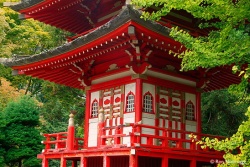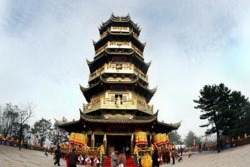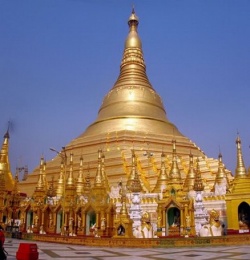Development of Pagodas
- The construction of pagodas was such a superb integration of foreign and traditional Chinese architectural styles by ancient Chinese architects that it has won respect and admiration all over the world.
- Indian stupas were originally characterized by a dome-shaped steeple, but combined with the traditional architectural styles of China, they acquired new forms of radiant splendor.
The earliest pagodas built in China were multistoreyed, as recorded in historical accounts.
For instance, the pagoda at the White Horse Temple near Luoyang, built in 68, the pagoda in Xuzhou, built between 188 and 193, and the one at Yongmng Temple in Luoyang, constructed in 516, are all tall buildings of seven or nine storeys.
- The main reasons early pagodas in China had many storeys were, first, since pagodas were originally built to preserve Buddhist relics, which were considered the most sacred objects in the world, representing Buddha, they should be majestic and striking in style.
Second, multistoreyed buildings were traditionally used by the ruling class to show off its power and wealth; they were also believed to be the residences of the immortals; therefore they were most suitable for enshrining the mysterious Buddha, the highest saint among the immortals. Third, high buildings of many storeys were usually awe inspiring and mysterious looking.
- The structure of Chinese pagodas can be divided into three parts: the top, the body and the base. The top resembled the original image of the stupa from India.
The body, or main part, of the pagoda, often used to enshrine a statue of Buddha, held to various styles of traditional Chinese architecture, unless the pagoda had a domed steeple.
The base, for burying Buddhist relics, usually took the form of an underground chamber or underground hole attached to a tomb in ancient China.
This kind of pagoda structure was recorded in ancient documents and shown in sculptures and murals in grottoes dug during the Southern and Northern Dynasties (420-589).
The earliest pagodas in China were either multistoreyed or pavilion-shaped structures, representing the most popular and exquisite styles in ancient Chinese architecture.
Later, with the development of architecture, changes in Buddhism and progress in engineering technology, pagodas of greater variety were built in China, such as multi-eared, pagodas with flowery ornaments,
pagodas built on vajrasanas, and pagodas built across roads.
All the different kinds of pagodas, including the Lamaist dagobas most similar to the original style of Indian stupas, have assumed Chinese characteristics in architectural style and ornaments.
- Since the relationship of pagoda and temple was very close and since the pagoda was the main part of the temple in its early period of development, we shall explore the relationship between the two architectural forms and their development in history.
The first Buddhist temple in China, the White Horse Temple, was constructed with a huge square wooden pagoda as the central building, surrounded by verandas and halls.
According to "Shi Lao Zhi, " Wei Shu ("History of Buddhism,"
History of the Wei Dynasty), following the example of theWhite Horse Temple in Luoyang, more Buddhist temples were built and decorated with exquisite sculptures and murals.
Since the original Buddhist pagodas in India were square, all Buddhist temples in China were constructed with square pagodas. Some were single-storey structures; others had three, five, seven or nine storeys.
- Though History of the Wei Dynasty was written about four hundred years after theWhite Horse Temple was built, it still provided a true picture of the style of temple pagodas in China at that time.
What merits special attention is the so-called palace pagoda system mentioned in the book.
"Palace here means the traditional style of Chinese palaces. Pagodas were not related to palaces until they were introduced from India to China.
Since palaces in China were used as official buildings, pagodas with palaces attached to them attained a higher status in society.
The most important structure in a Buddhist temple was still, however, designed after the stupa, the tomb of Buddhist relics, representing the Buddha himself.
To enhance its loftiness, the stupa-shaped structure was elevated to the highest part of the building, called sha (the steeple of a pagoda) by Chinese architects in ancient times.
The remaining temple buildings--palaces, verandas, gateways, etc. --still followed traditional Chinese styles.
- According to "Liu You Zhuan', San Guo zhi ("Biography of Liu You," History of the Three Kingdoms), a Buddhist temple was built between 188 and 193 by [[Ze [Rong]] in Xuzhou, Jiangsu Province.
Enshrined in the main hall of the temple was a statue of Buddha made of cast bronze and dressed in colourful brocade and embroideries. In the temple was a pagoda topped by a nine-tiered bronze steeple.
Other buildings and roofed-corridors were attached to it. The temple was so large it could hold more than three thousand worshippers at one time.
- Explanations of the relationship between temples and pagodas and more detailed descriptions of temple and pagoda structures can be found in the book Luo Yang Qie Lan Ji (Stories About Buddhist Temples in Luoyang) by Yang Xuanzhi of the Northern Wei Dynasty. A chapter about Yongning Temple says that the temple was built in 516 by an order of Empress Dowager Hu.
Then a nine-storey wooden pagoda was built in the temple.
To the north of the pagoda stood the main hall of the temple, which resembled the style of the Taiji Hall in the imperial palace. The temple had more than a thousand rooms for the monks to live in. Verandas and walls were built around the temple building and four grand gateways were installed, facing four directions.
- This account of the layout of the Yongning Temple tells us clearly that the pagoda used to be the central structure of the temple, which was surrounded by multistoreyed buildings and verandas.
Location of the main hall behind a pagoda is rarely found among existing temples today. Even the layout of White Horse Temple has changed after repeated reconstruction over the years.
Though the original temple layout before the Tang Dynasty (618-907) cannot be traced, we can still learn the location of a pagoda in a temple during the early period of Buddhist development in China from Japanese temples.
According to research by Japanese scholars, the Flying Bird Temple and the Four Devarajas Temple in Japan both followed the design of the White Horse Temple of Luoyang.
They were built during a period corresponding to China's Southern and Northern Dynasties (420-589), and both were constructed with a pagoda at the center surrounded by balconies and the main hall attached to its back.
Since the two Japanese temples closely resemble descriptions of Yongning Temple in Luoyang and the dates of construction were near each other, the two Japanese temples can serve as good examples in studying Chinese pagodas in the early period.
- The layout of temples remained basically unchanged until the Sui and early Tang dynasties. Beginning in the Tang Dynasty, however, drastic changes took place in the structure of temple buildings.
The status of the main hall, as the place of worship and prayer, was elevated, first by building a temple and a pagoda side by side and later by moving the pagoda out of the temple compound.
This change was caused by further development of Buddhism in China and the influence of traditional Chinese architecture in the construction of Buddhist temples.
During the early Tang Dynasty the founder of the L| Sect of Buddhism, Dao Xuan (596-667), worked out a "standard design for Buddhist temple construction" by which the pagoda gave place to the vihara--the main hall--as the dominant part of a Buddhist temple.
Dan Xuan's "standard design" was influenced by traditional Chinese architecture, two factors of which should be mentioned in particular.
The first is the composition of several related courtyards in the housing structure inherited from the Yin (also called Shang) and Zhou dynasties (sixteenth century to 221 B.C.).
It was an old tradition adopted in the construction of palaces, temples, altars, official buildings and civilian residences alike.
Since the purpose of building Buddhist temples was to spread religious teachings, they should follow a pattern acceptable to all social strata in the country.
The second factor causing changes in the architectural styles of temples was the increasing use of residences as Buddhist shrines.
As Buddhism spread in China, many high officials, big landlords, powerful merchants as well as dukes, princes, and even emperors offered their palaces and houses as Buddhist temples to show their respect for and loyalty to Buddhism.
For instance, the book Stories About Buddhist Temples in Luoyang recorded a story about a man, Du Zixiu, from Chongyili who donated his house to Buddhism.
The story says that under the reign of Emperor Zhengguang (520-524) of the Northern Wei Dynasty a recluse by the name of Zhao Yi, who lived on the site of the Jin Dynasty Taikang Temple, once dug out tens of thousands of used bricks and a stone tablet with inscriptions dating back to 285.
When Du heard the story, he decided to donate his own house to Buddhism and had it rebuilt into a Buddhist temple, named the Lingying Temple.
He also used the old bricks dug out from Zhao Yi's house to build a pagoda of three storeys.
The earliest existing Buddhist temple in China, the Songyue Temple, was donated by an emperor.
According to historical records. Songyue Temple was originally called Xianju Temple (Temple of Leisure Residence) and had been used as a palace by Emperor Xuanwu of the Northern Wei Dynasty when he was away from the capital.
It was first built between 508 and 512. In 520 the structure was enlarged and a brick pagoda added.
Later a son of Emperor Xuanwu had it reconstructed into a Buddhist temple surrounded by a picturesque garden.
"Feng Liang Zhuan," Bei Shi ("Biography of Feng Liang," History of the Northern Dynasties), says that the temple "claims a wonderful view of woods and springs and beautiful decorations;
it is a truly excellent resort in quiet mountains."
These two examples depict the assimilation of Buddhist buildings by traditional Chinese architecture.
In fact, the adoption of such typical Chinese structures as palaces and residences for Buddhist temples proves that Buddhist temples were gradually Sinicized after their introduction into China.
- By the Song Dynasty (960-1279) Buddhist temples of the Chan Sect had developed a new architectural style called the "seven-part structure," according to which a Buddhist temple should be composed of seven parts: the Buddha hall, the dharma hall,
the monks' bedrooms, the depository, the gate, the room representing the Pure Land in the West and bathrooms. The original style of Buddhist temples from India was completely replaced by the palace-and-courtyard patterns of Chinese architecture.
- A later example of turning a palace into a temple is the famous Yonghegong (Palace of Harmony and Peace) lamasery in Beijing. Originally a residence of Emperor Yongzheng of theQing Dynasty before he was enthroned, it was donated as a lamasery after the emperor's death.
Except for statues of Buddha and other Buddhist embellishments inside the buildings, the entire front structure of the lamasery has retained the style of a royal mansion.
The great pavilion containing the statue of Buddha, the Wanfu Pavilion (Pavilion of Eternal Happiness), was added during the reign of Emperor Qianlong (1736-95).
But where is the pagoda that is typical of a Buddhist temple? It was cleverly put on top of the Dharmacakra Hall, where the statue of Zongkaba, founder of the Yellow Sect of Lamaism, was enshrined. It had become part of the roof ornaments.
- As to whether a pagoda was called a zhenshen sarira pagoda (in which the real remains of Buddha or saints were buried) or a fashen sarira pagoda (in which the souls of Buddha or saints were supposed to be buried) was determined by what it actually contained.
Most pagodas are called zhenshen sarira pagodas or sarira pagodas[[]]; rarely is a pagoda called a fashen pagoda, because the real remains of Buddha or saints are more likely to win the respect and loyalty of the people.



